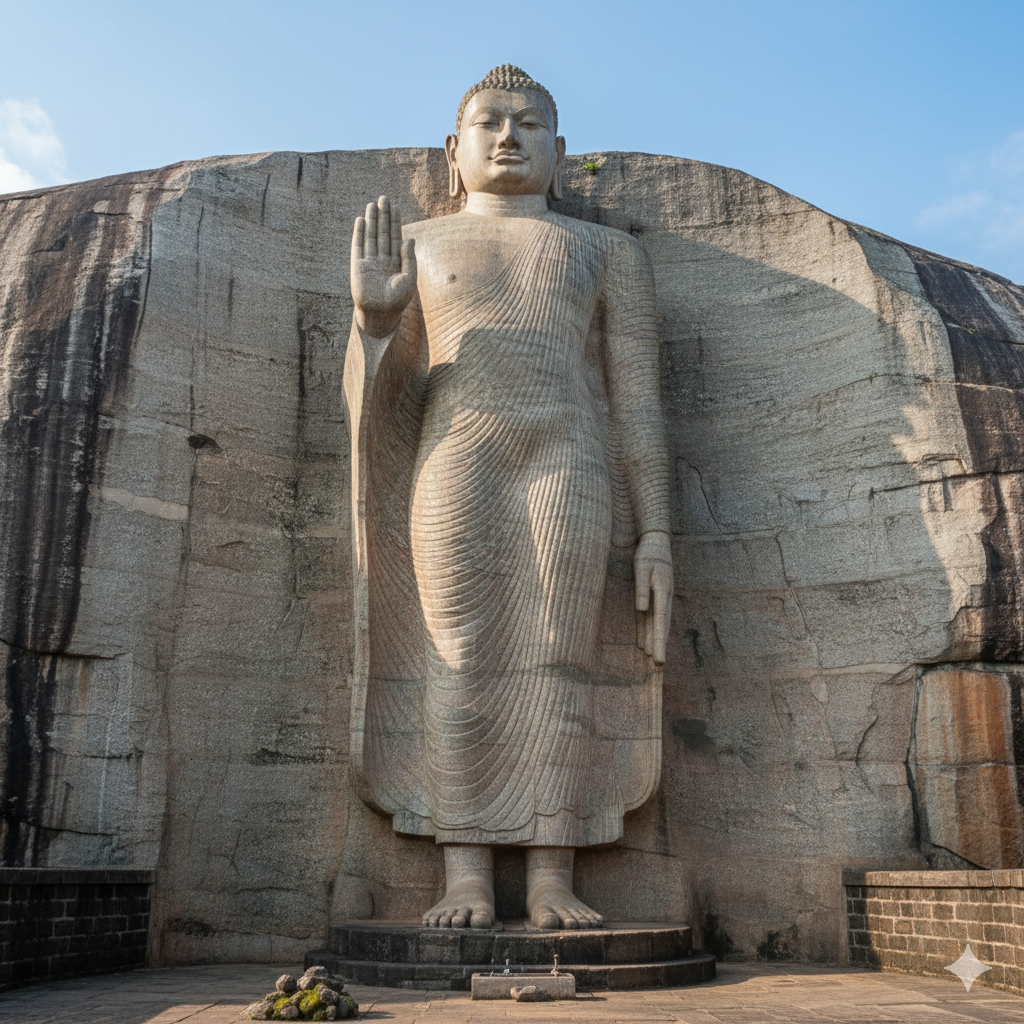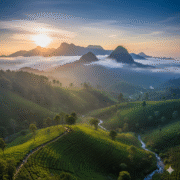
The Avukana Buddha: A Colossal Granite Guardian in Sri Lanka’s Cultural Heart
- November 13, 2025
- eunoialankatours
- 6:49 pm
Nestled between the wildfowl of Kala Wewa and a sleepy North-Central village stands a figure that has watched Sri Lanka’s landscape for more than a millennium. Travellers driving north from Dambulla or east from Anuradhapura see it from a distance – a slender, rock-cut Buddha rising above the scrub like a sentinel. Turn off the dusty road toward the Kala Wewa reservoir and follow a path lined with frangipani; ahead is the Avukana (or Aukana) Buddha, a masterpiece of Sinhalese sculpture.
Early morning is the perfect time to visit; dawn sunlight catches the folds of its robe and seems to make the stone glow. Local people call the site “Ow-kene” (“sun-bathing”) because the statue faces east to greet the first rays of dawn.
Carved from the Living Rock
Avukana’s Buddha is one of only five colossal standing Buddhas carved in Sri Lanka, and it is arguably the best preserved.
- Engineering: The image is carved out of a single granite face but is not fully detached; a narrow spine of stone runs down its back, anchoring it to the cliff.
- Scale: From the lotus to the tip of the head the statue measures about 11.84 m (roughly 38 ft 10 in); when the lotus plinth is included the total height exceeds 14 m.
- Proportions: The figure follows a strict nine-face canon of iconometry—at nearly twelve metres tall, the figure has the proportions of nine facial lengths from crown to feet, a system shared with Gupta-period Buddhas in India.
Artistic Details:
The robe clings so tightly that it reveals the curves of the Buddha’s torso. It falls in single grooves over the left shoulder and down to the ankles, leaving the right shoulder bare. Locals boast that a raindrop sliding off the nose will fall exactly between the statue’s toes – a testament to the sculptor’s precision..
- Head: A flame-like siraspata (ushnisha) symbolises enlightenment, and curled hair frames an oval face with a serene smile.
- Gesture (Mudrā): The right hand is raised shoulder-high with the palm facing left; this variation of the abhaya mudra is called āsisa (or ashisa) mudra and signifies blessing and reassurance. The left hand rests gracefully on the robe’s folds.
- Cosmology: Beneath the pedestal, a hollow chamber once held bronze images of Hindu gods (Indra, Brahma, Kuvera, etc.). Their placement at the Buddha’s feet illustrates the cosmological hierarchy in Mahayana Buddhism, where the Buddha towers above celestial deities.
Dating and Symbolism
Dating Avukana has long been debated. Traditional chronicles credit King Dhātusena (459–477 CE) with commissioning the statue. Modern scholarship, however, points toward a later date, likely the late Anurādhapura period (8th–10th centuries), based on a Sinhala donative inscription found nearby.
Symbolism and Artistic Influences:
Avukana was carved during a time when Mahayana ideas were gaining popularity in Sri Lanka.
- Scale: Its monumental scale and cosmic imagery reflect a belief in the Buddha’s transmundane nature.
- Style: The style blends local Anuradhapura traditions with influences from the Indian Gandhara and Amaravati schools, evident in the realistic drapery and elongated proportions.
- The Āsisa Mudrā is a gesture mostly found in Sri Lankan standing Buddhas.
- Orientation: The name Avukana itself is often translated as “sun-bathing,” a reference to the statue’s orientation toward the rising sun. Visitors who time their arrival with sunrise often remark that the statue seems to come alive as it catches the light.
Legends, Folklore, and Later Life
Beyond the chronology, Avukana is wrapped in folklore. One story recounts that the eyes once emitted a guiding light to help travellers. In recent years, swarms of black bees have nested in the statue’s crevices, and locals view them as natural guardians. The statue’s continuing symbolic power is evident: a modern replica stands near the Bandaranaike Memorial International Conference Hall in Colombo.
Visiting Avukana
Avukana is easy to include on a journey through Sri Lanka’s Cultural Triangle. It lies about 30 km northwest of Dambulla and roughly 50 km south of Anuradhapura, near the village of Kekirawa.
- Approach: Approaching the site you pass paddy fields, banana groves and the shimmering expanse of Kala Wewa.
- Image House: Only fragments of the original image house remain; its walls once measured 23 m long and 19 m wide, providing a covered shrine and ambulatory for monks and pilgrims.
- Tip for Visitors: The best time to visit is just after dawn when the sun catches the carved granite. Dress respectfully, bring water and remove your shoes before walking up the stone causeway.
Standing in Avukana’s presence, one feels a kinship with the monks and pilgrims who have made this journey for over a thousand years. Visiting Avukana is both a cultural exploration and a meditation on the endurance of human creativity.


